Importance Of Out Reach Community Engagement Assessment 2022
VerifiedAdded on 2022/09/23
|8
|2207
|29
AI Summary
Contribute Materials
Your contribution can guide someone’s learning journey. Share your
documents today.
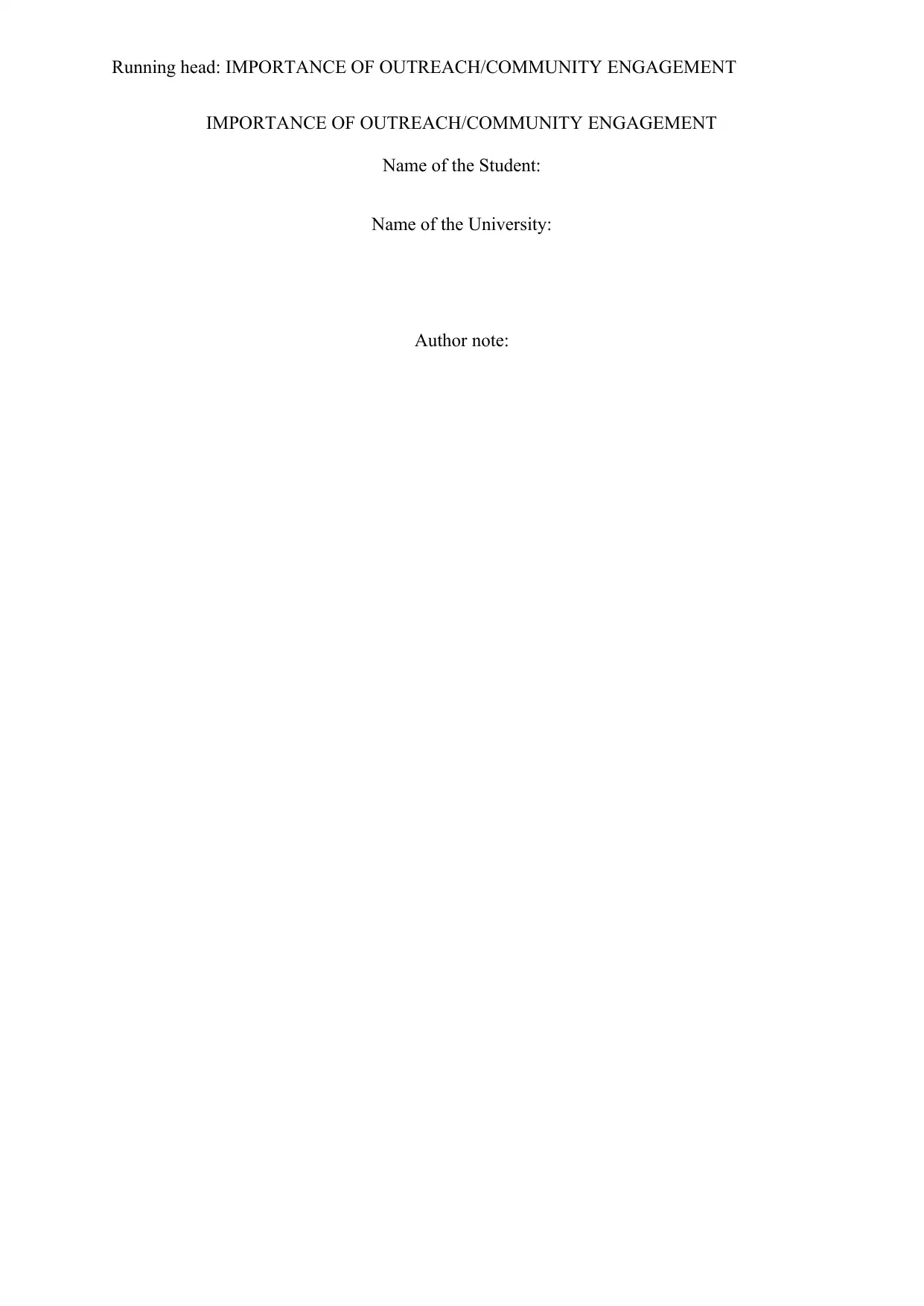
Running head: IMPORTANCE OF OUTREACH/COMMUNITY ENGAGEMENT
IMPORTANCE OF OUTREACH/COMMUNITY ENGAGEMENT
Name of the Student:
Name of the University:
Author note:
IMPORTANCE OF OUTREACH/COMMUNITY ENGAGEMENT
Name of the Student:
Name of the University:
Author note:
Secure Best Marks with AI Grader
Need help grading? Try our AI Grader for instant feedback on your assignments.
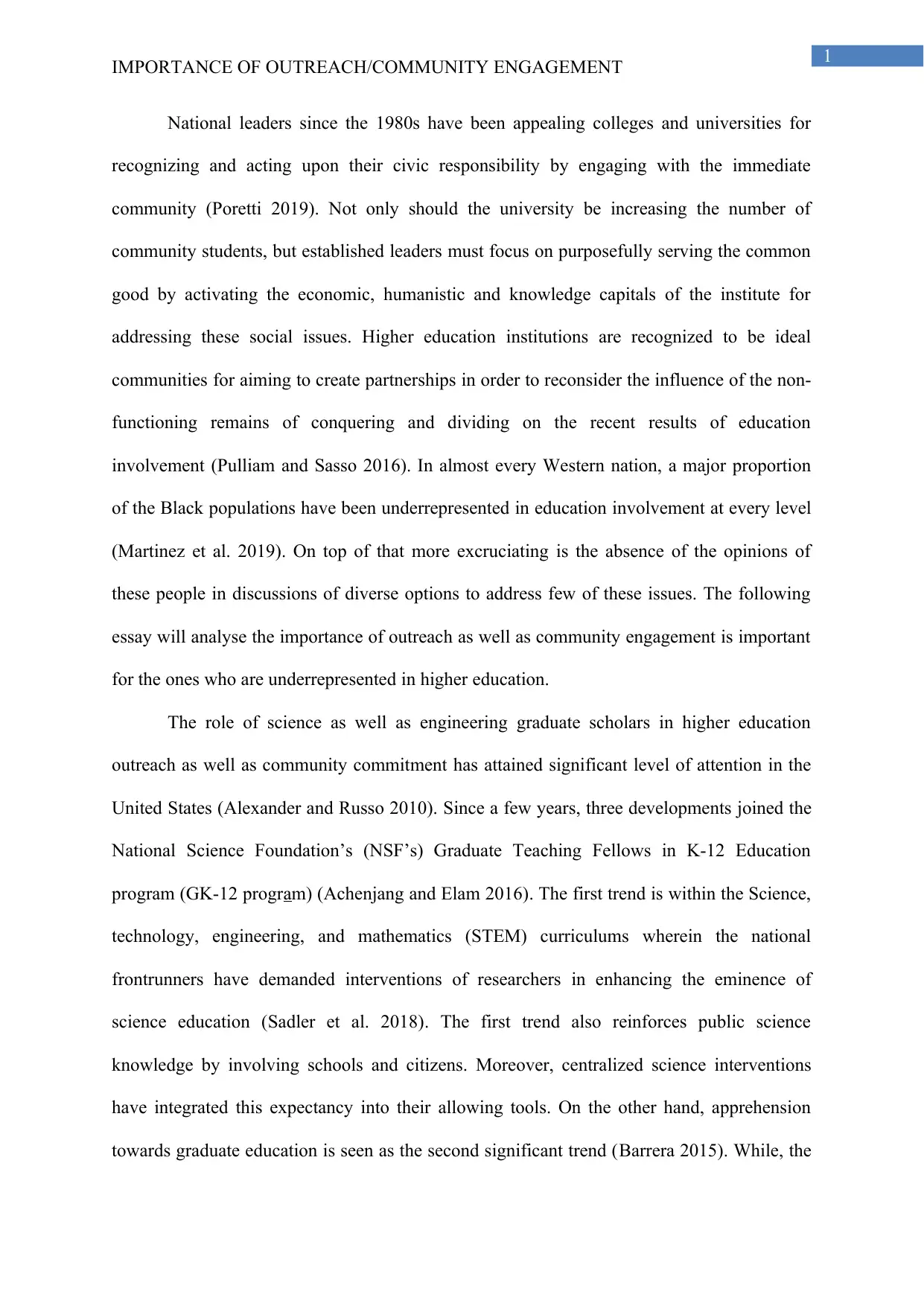
1
IMPORTANCE OF OUTREACH/COMMUNITY ENGAGEMENT
National leaders since the 1980s have been appealing colleges and universities for
recognizing and acting upon their civic responsibility by engaging with the immediate
community (Poretti 2019). Not only should the university be increasing the number of
community students, but established leaders must focus on purposefully serving the common
good by activating the economic, humanistic and knowledge capitals of the institute for
addressing these social issues. Higher education institutions are recognized to be ideal
communities for aiming to create partnerships in order to reconsider the influence of the non-
functioning remains of conquering and dividing on the recent results of education
involvement (Pulliam and Sasso 2016). In almost every Western nation, a major proportion
of the Black populations have been underrepresented in education involvement at every level
(Martinez et al. 2019). On top of that more excruciating is the absence of the opinions of
these people in discussions of diverse options to address few of these issues. The following
essay will analyse the importance of outreach as well as community engagement is important
for the ones who are underrepresented in higher education.
The role of science as well as engineering graduate scholars in higher education
outreach as well as community commitment has attained significant level of attention in the
United States (Alexander and Russo 2010). Since a few years, three developments joined the
National Science Foundation’s (NSF’s) Graduate Teaching Fellows in K-12 Education
program (GK-12 program) (Achenjang and Elam 2016). The first trend is within the Science,
technology, engineering, and mathematics (STEM) curriculums wherein the national
frontrunners have demanded interventions of researchers in enhancing the eminence of
science education (Sadler et al. 2018). The first trend also reinforces public science
knowledge by involving schools and citizens. Moreover, centralized science interventions
have integrated this expectancy into their allowing tools. On the other hand, apprehension
towards graduate education is seen as the second significant trend (Barrera 2015). While, the
IMPORTANCE OF OUTREACH/COMMUNITY ENGAGEMENT
National leaders since the 1980s have been appealing colleges and universities for
recognizing and acting upon their civic responsibility by engaging with the immediate
community (Poretti 2019). Not only should the university be increasing the number of
community students, but established leaders must focus on purposefully serving the common
good by activating the economic, humanistic and knowledge capitals of the institute for
addressing these social issues. Higher education institutions are recognized to be ideal
communities for aiming to create partnerships in order to reconsider the influence of the non-
functioning remains of conquering and dividing on the recent results of education
involvement (Pulliam and Sasso 2016). In almost every Western nation, a major proportion
of the Black populations have been underrepresented in education involvement at every level
(Martinez et al. 2019). On top of that more excruciating is the absence of the opinions of
these people in discussions of diverse options to address few of these issues. The following
essay will analyse the importance of outreach as well as community engagement is important
for the ones who are underrepresented in higher education.
The role of science as well as engineering graduate scholars in higher education
outreach as well as community commitment has attained significant level of attention in the
United States (Alexander and Russo 2010). Since a few years, three developments joined the
National Science Foundation’s (NSF’s) Graduate Teaching Fellows in K-12 Education
program (GK-12 program) (Achenjang and Elam 2016). The first trend is within the Science,
technology, engineering, and mathematics (STEM) curriculums wherein the national
frontrunners have demanded interventions of researchers in enhancing the eminence of
science education (Sadler et al. 2018). The first trend also reinforces public science
knowledge by involving schools and citizens. Moreover, centralized science interventions
have integrated this expectancy into their allowing tools. On the other hand, apprehension
towards graduate education is seen as the second significant trend (Barrera 2015). While, the
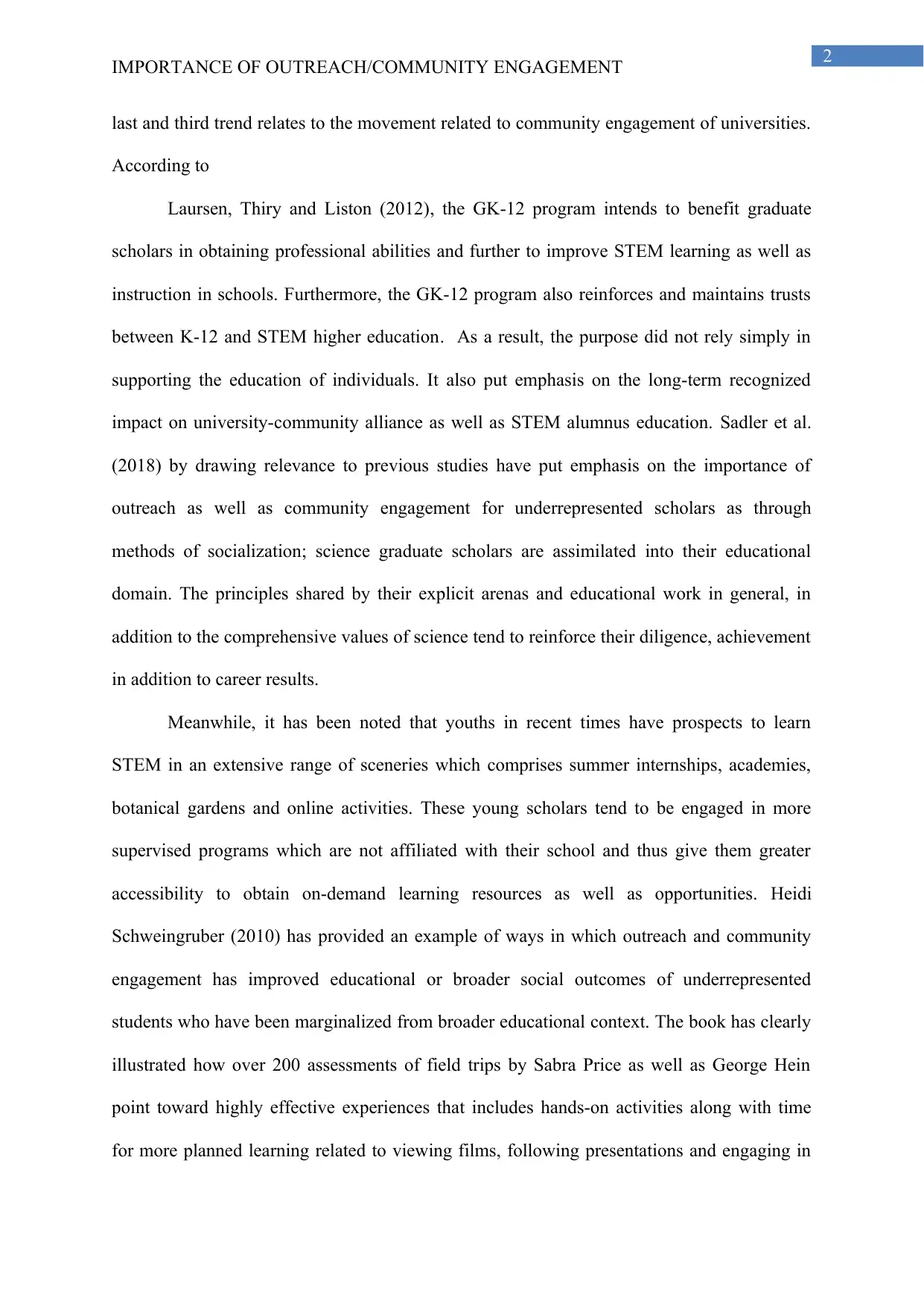
2
IMPORTANCE OF OUTREACH/COMMUNITY ENGAGEMENT
last and third trend relates to the movement related to community engagement of universities.
According to
Laursen, Thiry and Liston (2012), the GK-12 program intends to benefit graduate
scholars in obtaining professional abilities and further to improve STEM learning as well as
instruction in schools. Furthermore, the GK-12 program also reinforces and maintains trusts
between K-12 and STEM higher education. As a result, the purpose did not rely simply in
supporting the education of individuals. It also put emphasis on the long-term recognized
impact on university-community alliance as well as STEM alumnus education. Sadler et al.
(2018) by drawing relevance to previous studies have put emphasis on the importance of
outreach as well as community engagement for underrepresented scholars as through
methods of socialization; science graduate scholars are assimilated into their educational
domain. The principles shared by their explicit arenas and educational work in general, in
addition to the comprehensive values of science tend to reinforce their diligence, achievement
in addition to career results.
Meanwhile, it has been noted that youths in recent times have prospects to learn
STEM in an extensive range of sceneries which comprises summer internships, academies,
botanical gardens and online activities. These young scholars tend to be engaged in more
supervised programs which are not affiliated with their school and thus give them greater
accessibility to obtain on-demand learning resources as well as opportunities. Heidi
Schweingruber (2010) has provided an example of ways in which outreach and community
engagement has improved educational or broader social outcomes of underrepresented
students who have been marginalized from broader educational context. The book has clearly
illustrated how over 200 assessments of field trips by Sabra Price as well as George Hein
point toward highly effective experiences that includes hands-on activities along with time
for more planned learning related to viewing films, following presentations and engaging in
IMPORTANCE OF OUTREACH/COMMUNITY ENGAGEMENT
last and third trend relates to the movement related to community engagement of universities.
According to
Laursen, Thiry and Liston (2012), the GK-12 program intends to benefit graduate
scholars in obtaining professional abilities and further to improve STEM learning as well as
instruction in schools. Furthermore, the GK-12 program also reinforces and maintains trusts
between K-12 and STEM higher education. As a result, the purpose did not rely simply in
supporting the education of individuals. It also put emphasis on the long-term recognized
impact on university-community alliance as well as STEM alumnus education. Sadler et al.
(2018) by drawing relevance to previous studies have put emphasis on the importance of
outreach as well as community engagement for underrepresented scholars as through
methods of socialization; science graduate scholars are assimilated into their educational
domain. The principles shared by their explicit arenas and educational work in general, in
addition to the comprehensive values of science tend to reinforce their diligence, achievement
in addition to career results.
Meanwhile, it has been noted that youths in recent times have prospects to learn
STEM in an extensive range of sceneries which comprises summer internships, academies,
botanical gardens and online activities. These young scholars tend to be engaged in more
supervised programs which are not affiliated with their school and thus give them greater
accessibility to obtain on-demand learning resources as well as opportunities. Heidi
Schweingruber (2010) has provided an example of ways in which outreach and community
engagement has improved educational or broader social outcomes of underrepresented
students who have been marginalized from broader educational context. The book has clearly
illustrated how over 200 assessments of field trips by Sabra Price as well as George Hein
point toward highly effective experiences that includes hands-on activities along with time
for more planned learning related to viewing films, following presentations and engaging in
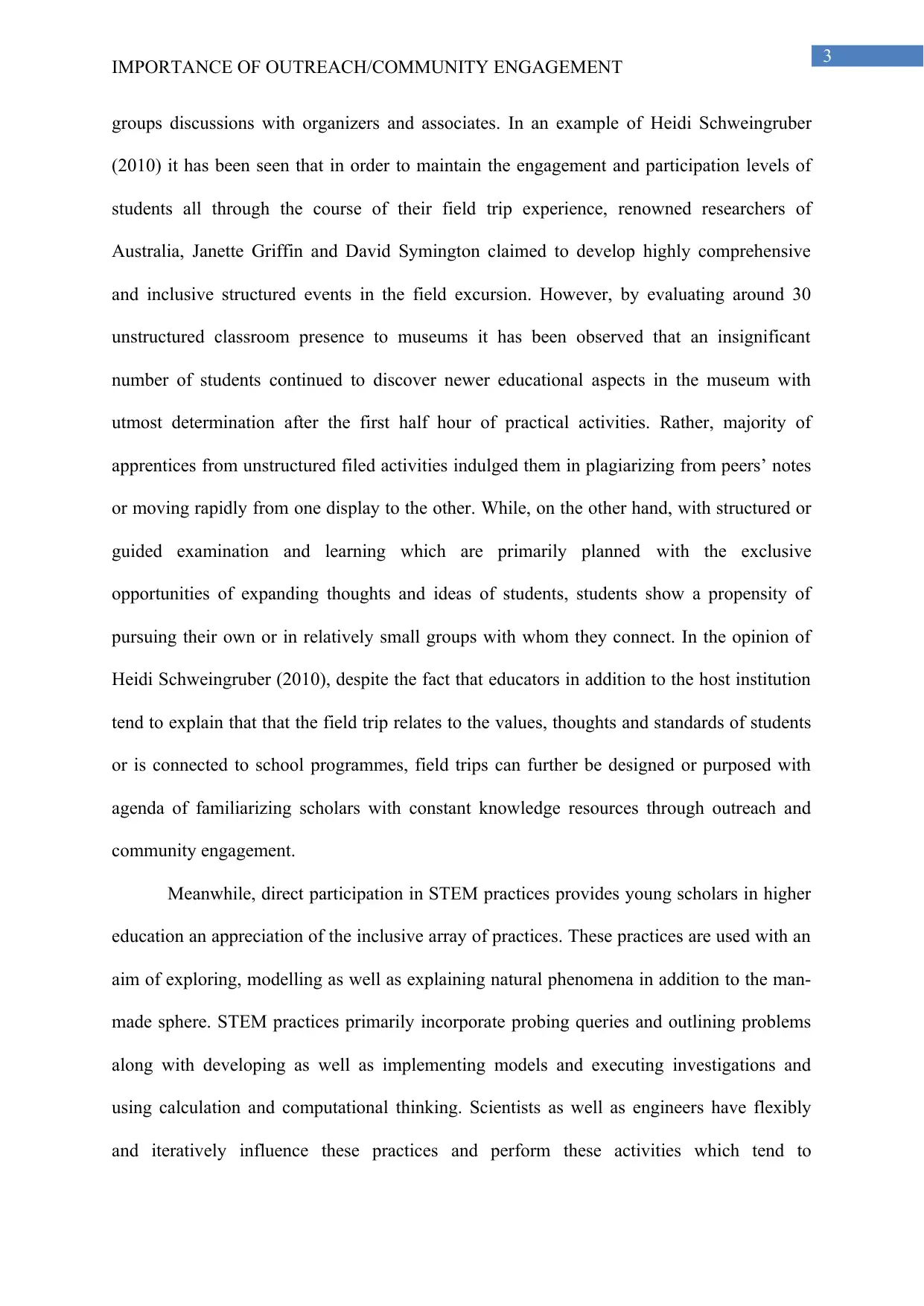
3
IMPORTANCE OF OUTREACH/COMMUNITY ENGAGEMENT
groups discussions with organizers and associates. In an example of Heidi Schweingruber
(2010) it has been seen that in order to maintain the engagement and participation levels of
students all through the course of their field trip experience, renowned researchers of
Australia, Janette Griffin and David Symington claimed to develop highly comprehensive
and inclusive structured events in the field excursion. However, by evaluating around 30
unstructured classroom presence to museums it has been observed that an insignificant
number of students continued to discover newer educational aspects in the museum with
utmost determination after the first half hour of practical activities. Rather, majority of
apprentices from unstructured filed activities indulged them in plagiarizing from peers’ notes
or moving rapidly from one display to the other. While, on the other hand, with structured or
guided examination and learning which are primarily planned with the exclusive
opportunities of expanding thoughts and ideas of students, students show a propensity of
pursuing their own or in relatively small groups with whom they connect. In the opinion of
Heidi Schweingruber (2010), despite the fact that educators in addition to the host institution
tend to explain that that the field trip relates to the values, thoughts and standards of students
or is connected to school programmes, field trips can further be designed or purposed with
agenda of familiarizing scholars with constant knowledge resources through outreach and
community engagement.
Meanwhile, direct participation in STEM practices provides young scholars in higher
education an appreciation of the inclusive array of practices. These practices are used with an
aim of exploring, modelling as well as explaining natural phenomena in addition to the man-
made sphere. STEM practices primarily incorporate probing queries and outlining problems
along with developing as well as implementing models and executing investigations and
using calculation and computational thinking. Scientists as well as engineers have flexibly
and iteratively influence these practices and perform these activities which tend to
IMPORTANCE OF OUTREACH/COMMUNITY ENGAGEMENT
groups discussions with organizers and associates. In an example of Heidi Schweingruber
(2010) it has been seen that in order to maintain the engagement and participation levels of
students all through the course of their field trip experience, renowned researchers of
Australia, Janette Griffin and David Symington claimed to develop highly comprehensive
and inclusive structured events in the field excursion. However, by evaluating around 30
unstructured classroom presence to museums it has been observed that an insignificant
number of students continued to discover newer educational aspects in the museum with
utmost determination after the first half hour of practical activities. Rather, majority of
apprentices from unstructured filed activities indulged them in plagiarizing from peers’ notes
or moving rapidly from one display to the other. While, on the other hand, with structured or
guided examination and learning which are primarily planned with the exclusive
opportunities of expanding thoughts and ideas of students, students show a propensity of
pursuing their own or in relatively small groups with whom they connect. In the opinion of
Heidi Schweingruber (2010), despite the fact that educators in addition to the host institution
tend to explain that that the field trip relates to the values, thoughts and standards of students
or is connected to school programmes, field trips can further be designed or purposed with
agenda of familiarizing scholars with constant knowledge resources through outreach and
community engagement.
Meanwhile, direct participation in STEM practices provides young scholars in higher
education an appreciation of the inclusive array of practices. These practices are used with an
aim of exploring, modelling as well as explaining natural phenomena in addition to the man-
made sphere. STEM practices primarily incorporate probing queries and outlining problems
along with developing as well as implementing models and executing investigations and
using calculation and computational thinking. Scientists as well as engineers have flexibly
and iteratively influence these practices and perform these activities which tend to
Secure Best Marks with AI Grader
Need help grading? Try our AI Grader for instant feedback on your assignments.
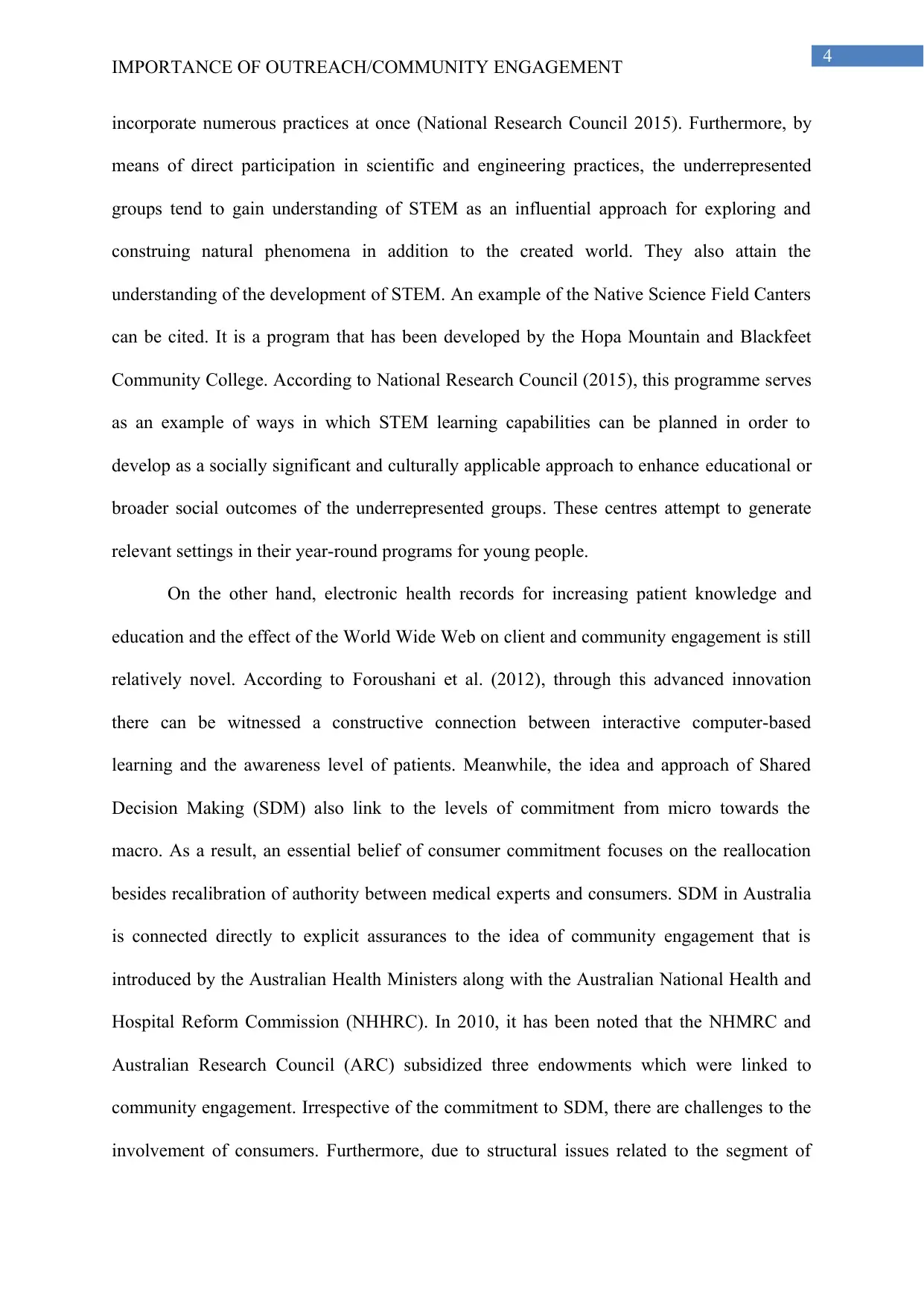
4
IMPORTANCE OF OUTREACH/COMMUNITY ENGAGEMENT
incorporate numerous practices at once (National Research Council 2015). Furthermore, by
means of direct participation in scientific and engineering practices, the underrepresented
groups tend to gain understanding of STEM as an influential approach for exploring and
construing natural phenomena in addition to the created world. They also attain the
understanding of the development of STEM. An example of the Native Science Field Canters
can be cited. It is a program that has been developed by the Hopa Mountain and Blackfeet
Community College. According to National Research Council (2015), this programme serves
as an example of ways in which STEM learning capabilities can be planned in order to
develop as a socially significant and culturally applicable approach to enhance educational or
broader social outcomes of the underrepresented groups. These centres attempt to generate
relevant settings in their year-round programs for young people.
On the other hand, electronic health records for increasing patient knowledge and
education and the effect of the World Wide Web on client and community engagement is still
relatively novel. According to Foroushani et al. (2012), through this advanced innovation
there can be witnessed a constructive connection between interactive computer-based
learning and the awareness level of patients. Meanwhile, the idea and approach of Shared
Decision Making (SDM) also link to the levels of commitment from micro towards the
macro. As a result, an essential belief of consumer commitment focuses on the reallocation
besides recalibration of authority between medical experts and consumers. SDM in Australia
is connected directly to explicit assurances to the idea of community engagement that is
introduced by the Australian Health Ministers along with the Australian National Health and
Hospital Reform Commission (NHHRC). In 2010, it has been noted that the NHMRC and
Australian Research Council (ARC) subsidized three endowments which were linked to
community engagement. Irrespective of the commitment to SDM, there are challenges to the
involvement of consumers. Furthermore, due to structural issues related to the segment of
IMPORTANCE OF OUTREACH/COMMUNITY ENGAGEMENT
incorporate numerous practices at once (National Research Council 2015). Furthermore, by
means of direct participation in scientific and engineering practices, the underrepresented
groups tend to gain understanding of STEM as an influential approach for exploring and
construing natural phenomena in addition to the created world. They also attain the
understanding of the development of STEM. An example of the Native Science Field Canters
can be cited. It is a program that has been developed by the Hopa Mountain and Blackfeet
Community College. According to National Research Council (2015), this programme serves
as an example of ways in which STEM learning capabilities can be planned in order to
develop as a socially significant and culturally applicable approach to enhance educational or
broader social outcomes of the underrepresented groups. These centres attempt to generate
relevant settings in their year-round programs for young people.
On the other hand, electronic health records for increasing patient knowledge and
education and the effect of the World Wide Web on client and community engagement is still
relatively novel. According to Foroushani et al. (2012), through this advanced innovation
there can be witnessed a constructive connection between interactive computer-based
learning and the awareness level of patients. Meanwhile, the idea and approach of Shared
Decision Making (SDM) also link to the levels of commitment from micro towards the
macro. As a result, an essential belief of consumer commitment focuses on the reallocation
besides recalibration of authority between medical experts and consumers. SDM in Australia
is connected directly to explicit assurances to the idea of community engagement that is
introduced by the Australian Health Ministers along with the Australian National Health and
Hospital Reform Commission (NHHRC). In 2010, it has been noted that the NHMRC and
Australian Research Council (ARC) subsidized three endowments which were linked to
community engagement. Irrespective of the commitment to SDM, there are challenges to the
involvement of consumers. Furthermore, due to structural issues related to the segment of
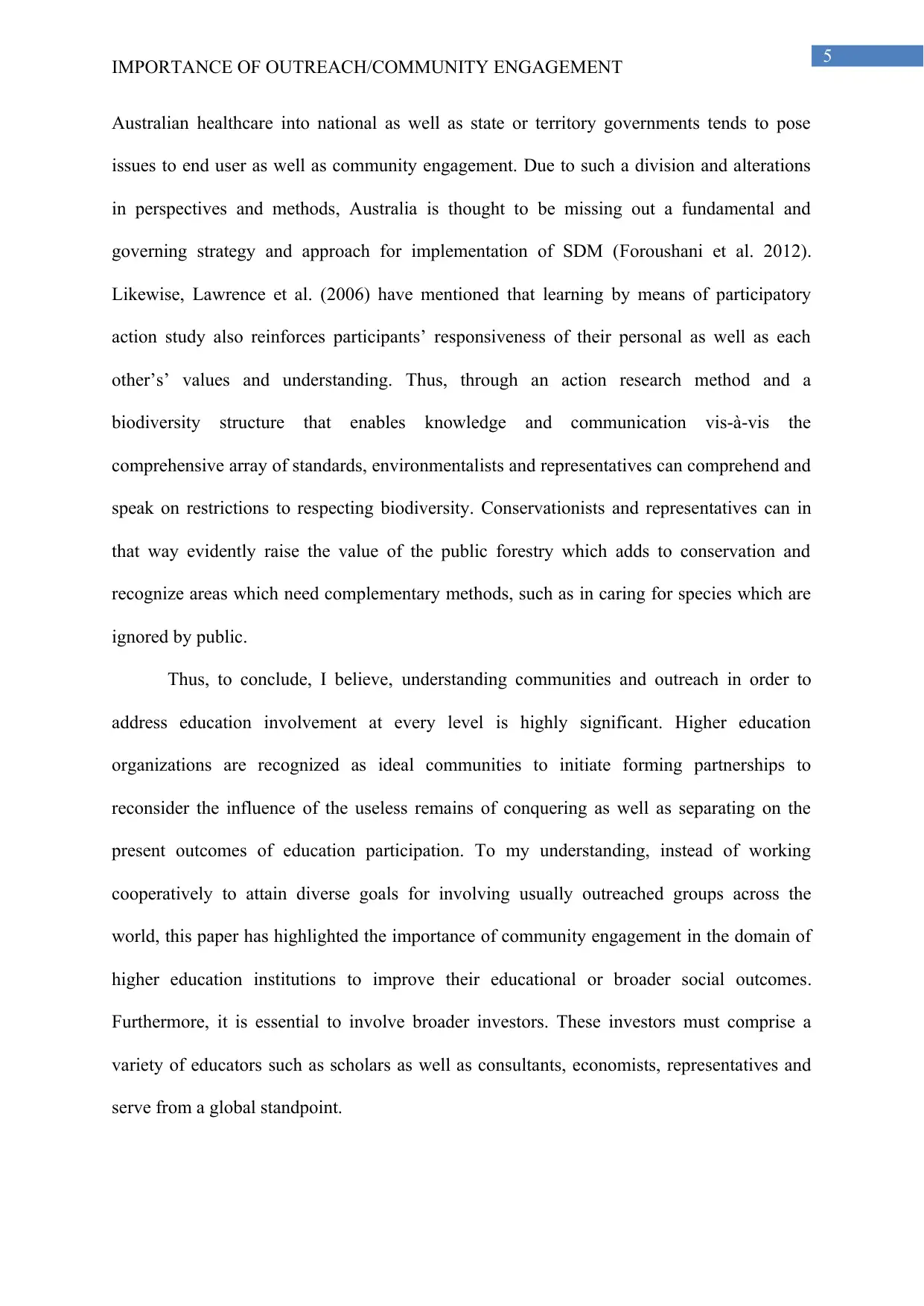
5
IMPORTANCE OF OUTREACH/COMMUNITY ENGAGEMENT
Australian healthcare into national as well as state or territory governments tends to pose
issues to end user as well as community engagement. Due to such a division and alterations
in perspectives and methods, Australia is thought to be missing out a fundamental and
governing strategy and approach for implementation of SDM (Foroushani et al. 2012).
Likewise, Lawrence et al. (2006) have mentioned that learning by means of participatory
action study also reinforces participants’ responsiveness of their personal as well as each
other’s’ values and understanding. Thus, through an action research method and a
biodiversity structure that enables knowledge and communication vis-à-vis the
comprehensive array of standards, environmentalists and representatives can comprehend and
speak on restrictions to respecting biodiversity. Conservationists and representatives can in
that way evidently raise the value of the public forestry which adds to conservation and
recognize areas which need complementary methods, such as in caring for species which are
ignored by public.
Thus, to conclude, I believe, understanding communities and outreach in order to
address education involvement at every level is highly significant. Higher education
organizations are recognized as ideal communities to initiate forming partnerships to
reconsider the influence of the useless remains of conquering as well as separating on the
present outcomes of education participation. To my understanding, instead of working
cooperatively to attain diverse goals for involving usually outreached groups across the
world, this paper has highlighted the importance of community engagement in the domain of
higher education institutions to improve their educational or broader social outcomes.
Furthermore, it is essential to involve broader investors. These investors must comprise a
variety of educators such as scholars as well as consultants, economists, representatives and
serve from a global standpoint.
IMPORTANCE OF OUTREACH/COMMUNITY ENGAGEMENT
Australian healthcare into national as well as state or territory governments tends to pose
issues to end user as well as community engagement. Due to such a division and alterations
in perspectives and methods, Australia is thought to be missing out a fundamental and
governing strategy and approach for implementation of SDM (Foroushani et al. 2012).
Likewise, Lawrence et al. (2006) have mentioned that learning by means of participatory
action study also reinforces participants’ responsiveness of their personal as well as each
other’s’ values and understanding. Thus, through an action research method and a
biodiversity structure that enables knowledge and communication vis-à-vis the
comprehensive array of standards, environmentalists and representatives can comprehend and
speak on restrictions to respecting biodiversity. Conservationists and representatives can in
that way evidently raise the value of the public forestry which adds to conservation and
recognize areas which need complementary methods, such as in caring for species which are
ignored by public.
Thus, to conclude, I believe, understanding communities and outreach in order to
address education involvement at every level is highly significant. Higher education
organizations are recognized as ideal communities to initiate forming partnerships to
reconsider the influence of the useless remains of conquering as well as separating on the
present outcomes of education participation. To my understanding, instead of working
cooperatively to attain diverse goals for involving usually outreached groups across the
world, this paper has highlighted the importance of community engagement in the domain of
higher education institutions to improve their educational or broader social outcomes.
Furthermore, it is essential to involve broader investors. These investors must comprise a
variety of educators such as scholars as well as consultants, economists, representatives and
serve from a global standpoint.
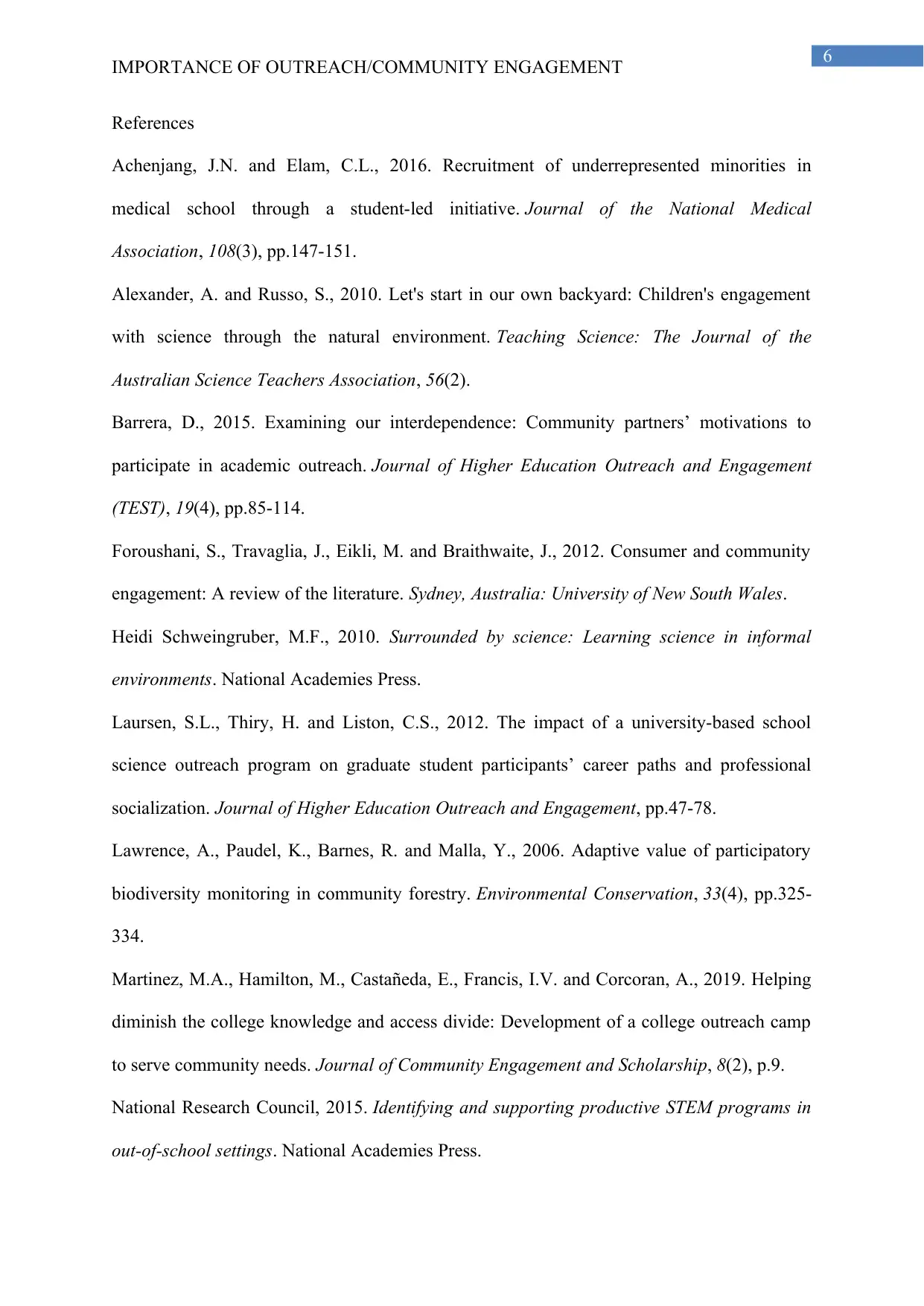
6
IMPORTANCE OF OUTREACH/COMMUNITY ENGAGEMENT
References
Achenjang, J.N. and Elam, C.L., 2016. Recruitment of underrepresented minorities in
medical school through a student-led initiative. Journal of the National Medical
Association, 108(3), pp.147-151.
Alexander, A. and Russo, S., 2010. Let's start in our own backyard: Children's engagement
with science through the natural environment. Teaching Science: The Journal of the
Australian Science Teachers Association, 56(2).
Barrera, D., 2015. Examining our interdependence: Community partners’ motivations to
participate in academic outreach. Journal of Higher Education Outreach and Engagement
(TEST), 19(4), pp.85-114.
Foroushani, S., Travaglia, J., Eikli, M. and Braithwaite, J., 2012. Consumer and community
engagement: A review of the literature. Sydney, Australia: University of New South Wales.
Heidi Schweingruber, M.F., 2010. Surrounded by science: Learning science in informal
environments. National Academies Press.
Laursen, S.L., Thiry, H. and Liston, C.S., 2012. The impact of a university-based school
science outreach program on graduate student participants’ career paths and professional
socialization. Journal of Higher Education Outreach and Engagement, pp.47-78.
Lawrence, A., Paudel, K., Barnes, R. and Malla, Y., 2006. Adaptive value of participatory
biodiversity monitoring in community forestry. Environmental Conservation, 33(4), pp.325-
334.
Martinez, M.A., Hamilton, M., Castañeda, E., Francis, I.V. and Corcoran, A., 2019. Helping
diminish the college knowledge and access divide: Development of a college outreach camp
to serve community needs. Journal of Community Engagement and Scholarship, 8(2), p.9.
National Research Council, 2015. Identifying and supporting productive STEM programs in
out-of-school settings. National Academies Press.
IMPORTANCE OF OUTREACH/COMMUNITY ENGAGEMENT
References
Achenjang, J.N. and Elam, C.L., 2016. Recruitment of underrepresented minorities in
medical school through a student-led initiative. Journal of the National Medical
Association, 108(3), pp.147-151.
Alexander, A. and Russo, S., 2010. Let's start in our own backyard: Children's engagement
with science through the natural environment. Teaching Science: The Journal of the
Australian Science Teachers Association, 56(2).
Barrera, D., 2015. Examining our interdependence: Community partners’ motivations to
participate in academic outreach. Journal of Higher Education Outreach and Engagement
(TEST), 19(4), pp.85-114.
Foroushani, S., Travaglia, J., Eikli, M. and Braithwaite, J., 2012. Consumer and community
engagement: A review of the literature. Sydney, Australia: University of New South Wales.
Heidi Schweingruber, M.F., 2010. Surrounded by science: Learning science in informal
environments. National Academies Press.
Laursen, S.L., Thiry, H. and Liston, C.S., 2012. The impact of a university-based school
science outreach program on graduate student participants’ career paths and professional
socialization. Journal of Higher Education Outreach and Engagement, pp.47-78.
Lawrence, A., Paudel, K., Barnes, R. and Malla, Y., 2006. Adaptive value of participatory
biodiversity monitoring in community forestry. Environmental Conservation, 33(4), pp.325-
334.
Martinez, M.A., Hamilton, M., Castañeda, E., Francis, I.V. and Corcoran, A., 2019. Helping
diminish the college knowledge and access divide: Development of a college outreach camp
to serve community needs. Journal of Community Engagement and Scholarship, 8(2), p.9.
National Research Council, 2015. Identifying and supporting productive STEM programs in
out-of-school settings. National Academies Press.
Paraphrase This Document
Need a fresh take? Get an instant paraphrase of this document with our AI Paraphraser
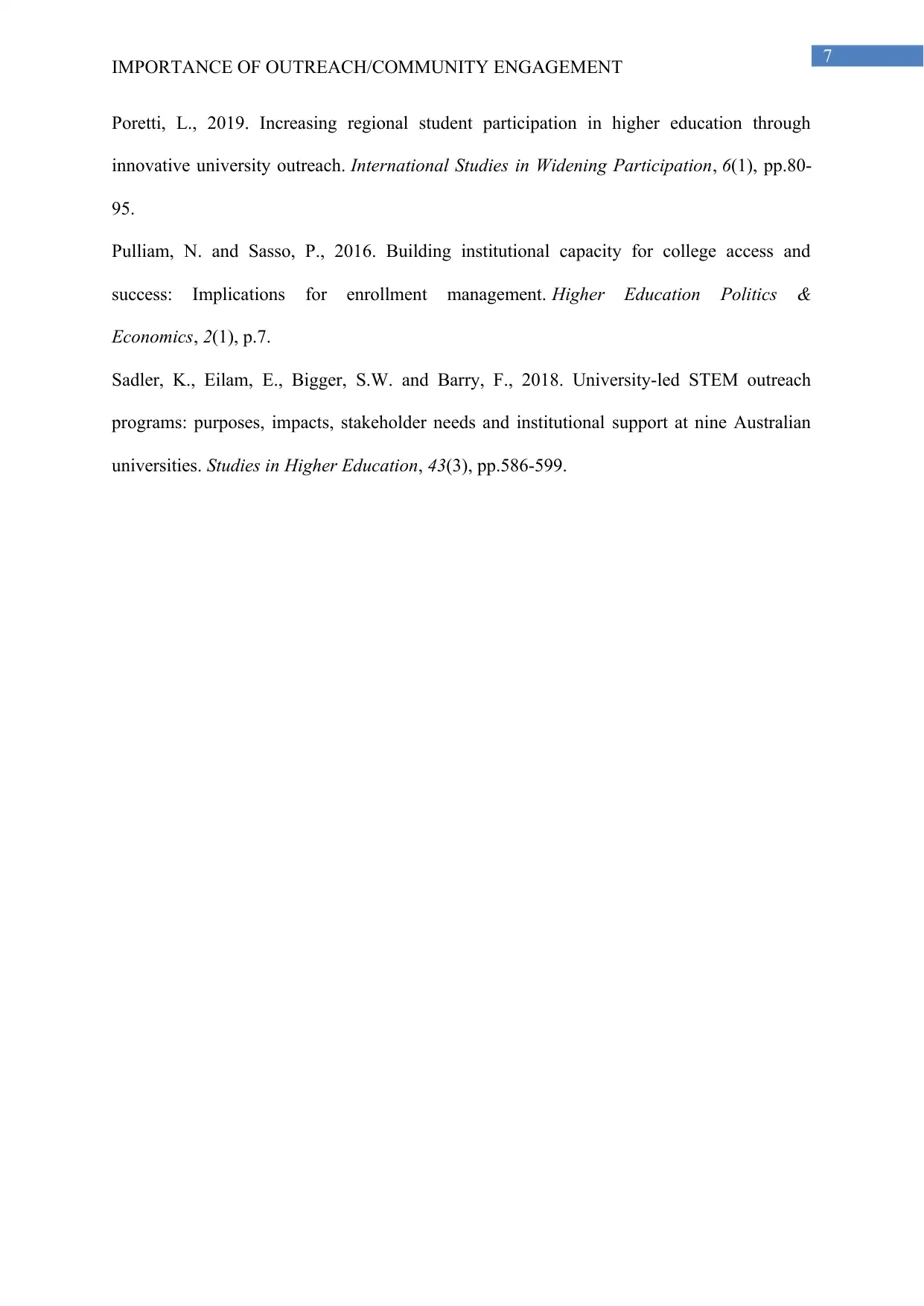
7
IMPORTANCE OF OUTREACH/COMMUNITY ENGAGEMENT
Poretti, L., 2019. Increasing regional student participation in higher education through
innovative university outreach. International Studies in Widening Participation, 6(1), pp.80-
95.
Pulliam, N. and Sasso, P., 2016. Building institutional capacity for college access and
success: Implications for enrollment management. Higher Education Politics &
Economics, 2(1), p.7.
Sadler, K., Eilam, E., Bigger, S.W. and Barry, F., 2018. University-led STEM outreach
programs: purposes, impacts, stakeholder needs and institutional support at nine Australian
universities. Studies in Higher Education, 43(3), pp.586-599.
IMPORTANCE OF OUTREACH/COMMUNITY ENGAGEMENT
Poretti, L., 2019. Increasing regional student participation in higher education through
innovative university outreach. International Studies in Widening Participation, 6(1), pp.80-
95.
Pulliam, N. and Sasso, P., 2016. Building institutional capacity for college access and
success: Implications for enrollment management. Higher Education Politics &
Economics, 2(1), p.7.
Sadler, K., Eilam, E., Bigger, S.W. and Barry, F., 2018. University-led STEM outreach
programs: purposes, impacts, stakeholder needs and institutional support at nine Australian
universities. Studies in Higher Education, 43(3), pp.586-599.
1 out of 8
Your All-in-One AI-Powered Toolkit for Academic Success.
+13062052269
info@desklib.com
Available 24*7 on WhatsApp / Email
![[object Object]](/_next/static/media/star-bottom.7253800d.svg)
Unlock your academic potential
© 2024 | Zucol Services PVT LTD | All rights reserved.

